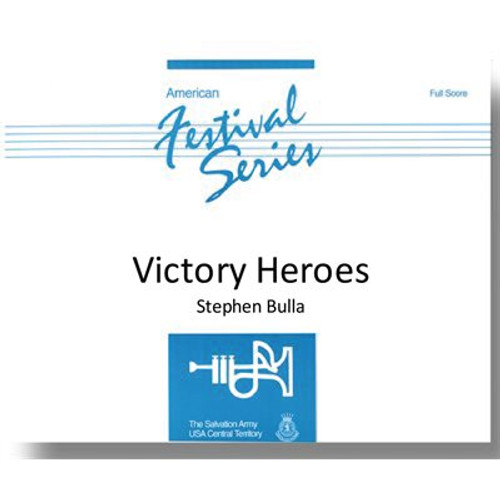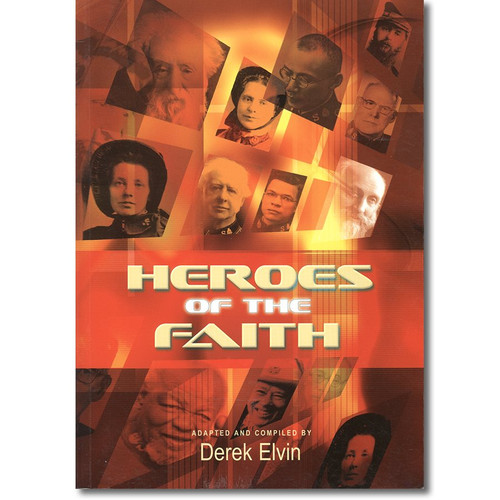Product Description
Victory Heroes
Composer: Stephen Bulla
Produced by The Salvation Army - Central Territory
Score Sample
NotesThis is a digital product. After purchasing you'll be able to download it from Account -> Orders -> Select order number
Score Notes
Notes:
Program Note:
This march was commissioned by Bandmaster Christopher Ward and the Eastern Michigan Divisional Band and includes a Salvation Army song from 1887, called "Marching On!" The original lyrics include these lines:
Marching on, marching on,
Against the powers of sin,
we the fight shall win,
Marching on, marching on,
we have victory through the Blood.
In addition to this melody, the march makes reference to the University of Michigan fight song that includes the words:
��Hail to the conquering heroes!" and thus the title to the march Victory Heroes.
Note to the Conductor:
Beginning to bar 13: Begin the march at a steady, moderate tempo, and measure the sixteenth figures evenly. Bars 7 to 9 will require careful rehearsal of the various sectional entrances.
Bars 13-26: At bar 13, maintain a steady pulse, paying attention to the exchange between the cornets and baritones/euphoniums, and later at bars 15 and 16 with the addition of the soprano and horns. At bar 17 the sixteenth figurations on beats 1 and 2 in cornets and flugel are articulated, while the sixteenths on beats 3 and 4 in horns and euphonium are slurred. Note that portions of this repeated section are marked 2nd time only and/or both times.
Bars 27-38: Balance each successive entrance moving from euphoniums to horns, and then to baritones and cornets. Flugel and horns take the lead in bars 31 and 32. Bars 33 to 38 repeats music from the opening.
Bars 39-52: At bar 39 the principal theme is taken by the baritones and euphoniums. At bars 43 and 44 we revisit the articulated versus slurred sixteenth figuration we encountered earlier at bar 17.
Bar 53-73: At Bar 53, the Frederick Fry tune Marching On! Marching On! is introduced in horns and baritones playing legato against a staccato backdrop in divided euphoniums and basses. The key changes at bar 61 and now features the cornets and bells, with the tune shifting to trombones at bar 63 and 64, back to cornets, and then the trombones doubling the melody from bar 67. Take time to rehearse the four bars coming up to bar 74, working out the various articulations, and keeping the eighth notes generally short.
Bars 74-88: Another key change ushers in a bass melody section requiring crisp articulation from the euphoniums and basses. Cornets and trombones accentuate the end of each bar. Give attention to the scale figures in horns and baritones starting at bar 78 and following. After the second time bracket, a brief episode commencing six bars before bar 89 passes the tune from horns to backrow cornets and flugel and back to the horns before another key change at bar 89.
Bar 89 to end: In this final section, the trombones and baritones initially sound the Marching On! tune, and then it moves to horns and euphoniums. There are a lot of details to cover in these concluding bars, including the dramatic triplets and dynamic drop to mezzo-piano and sudden crescendo to fortissimo. Two ending options are available �C a short quick flourish, or a more extended dramatic conclusion.
Program Note:
This colorful selection uses three songs of contrasting idiom to portray a progression of the human condition from despair to triumph:
Although this is a more extended work (approximate duration: 9:00), the inclusion of optional introductions and endings provides added usefulness of presenting singular performances of these three songs as follows:
Sometimes I feel like a motherless child: Beginning to optional ending at bars 39-40.
Reach out and touch: Bar 42 to optional ending at bars 110-113.
Storm the forts of darkness: Begin with snare drum roll (can be a pause) one beat before 117. Play to end as written.
Program Note:
This beautiful setting for solo trombones and band of the folk song O Waly, O Waly is often associated with the words of Isaac Watts:Note to the Conductor:
We are pleased to present this sensitive setting as it was initially conceived for solo trombone. Written for the Amsterdam Staff Band's 2005 tour of the United Kingdom, it was later adapted as a feature for trombone ensemble, at the request of Salvationist Publishing & Supplies, where it appears in 2009 as General Series 2059.
We are grateful to SP&S for kindly giving permission to publish this solo version in the American Festival Series. Of this work, the arranger, Olaf Ritman writes: "I consider this song my personal testimony."
Beginning to bar 12: The accompaniment, particularly at the opening and closing of the piece, is atmospheric, with suspended muted chords supporting the rubato trombone solo. The judicious use of percussion (chimes, bass drum and suspended cymbal) will add to the color and mood. Be sure to cue the chimes at bars 3 and 6.
at bar 4, a clear downbeat cure for the bass drum will help clarify tempo following the soloist's pause. Also give attention to the muted sforzando in cornets and trombones in bar 8.
Bars 13-52: Following the ritardando at bar 12, it is essential for the conductor to establish the correct tempo at bar 13, allowing the soloist lyrical freedom and the ability to sustain long phrases as the tune begins at bar 16. The descending scale gesture at bar 39 should be measured, yet not overstated.
Bars 53-74: There is a slight slowing of tempo as soprano, flugel and horns take the theme while cornets, trombones and euphonium adding countermelody.
Bars 75 to end: Returning to the opening tempo, it will again be helpful to give clear cues for the chimes, bass drum and triangle from bars 75 to the end.
[Note: This solo can be heard on the Chicago Staff Band recording,Kurios, performed by Brett Tolcher]
Program Note:
The tune Randolph, by preeminent English composer Ralph Vaughan Williams was first published in 1906 as a setting of Jeremiah Rankin's hymn, of which the first verse reads:
Note to the Conductor:
William Gordon's stunning four verse setting of Randolph progresses from the quiet simplicity of unison cornets and with each succeeding verse builds to a magnificent organ-like finale.
Gratitude is expressed to the publisher and copyright holder, Oxford University Press, for granting permission to publish this brass setting in the American Festival Series.
Beginning to bar 9: A ceremonial snare drum roll is the sole accompaniment to the cornets opening unison rendering of the tune.
Bar 10-17: The mellow instruments (flugel, horns, baritones and euphoniums) provide a beautiful change of color here with 2nd horn, baritones and euphonium seamlessly adding harmony.
Bars 18-26: A two beat snare and bass drum roll signals the entrance of the cornets and trombones in a more brilliant third verse setting. Here the bass trombone is essential (cued in Eb bass). Bring out the rising soprano cornet line from bar 22.
Bar 27 to end: A dramatic percussion roll precedes the "open pipes" organ like sounds of the final verse at bar 27. Be sure to observe the swell in bar 30, followed by a dramatic decrescendo before building to the final climatic chords. Avoid any tendency to overblow while striving for the full sonorities of this majestic finale.
[Note: this setting is especially effective when performed as a benediction "in the round" with players grouped by sections surrounding the audience.]







